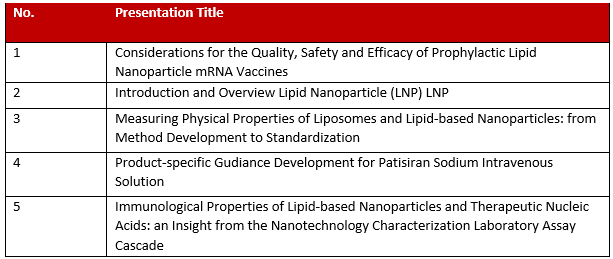-
ANMAT, Argentina
-
ANVISA, Brazil
-
COFEPRIS, Mexico
-
CPPS, Uzbekistan
-
EC, Europe
-
EDA, Egypt
-
FDA, United States
-
Health Canada, Canada
-
HSA, Singapore
-
MFDS, Republic of Korea
-
MHLW/PMDA, Japan
-
MHRA, UK
-
SFDA, Saudi Arabia
-
Swissmedic, Switzerland
-
TFDA, Chinese Taipei
-
TGA, Australia
-
TITCK, Türkiye
Nanomedicines are a rapidly emerging and evolving drug product category with the potential to provide earlier disease detection, improve the precision of diagnosis, and improve patient outcomes while potentially reducing adverse reactions and health care costs. This working group uniquely functions to disseminate knowledge in this field among international regulatory agencies, thereby improving the community’s understanding and capability to effectively regulate these products. The work of this group will ultimately improve the regulation of nanomedicines and nano-enabled medical products, providing more rapid access to high quality, effective medicines.
The International Regulators Working Group on Nanotechnology was established in the summer of 2009 to discuss nanotechnology-related issues relevant to regulated products that may contain nanoscale materials. The U.S. Food and Drug Administration (FDA) hosted the first meeting. Discussions focused on key issues such as the definition of nanotechnology, standards, biocompatibility, risk/safety assessments, and labeling.
The EMA hosted the first international workshop on Nanomedicines in 2009 and chaired since then biannual webinars / teleconferences with the International Working Group on Nanomedicines under confidentiality agreements.
As an emerging product category, nanotechnology-based therapies became a topic for the International Pharmaceutical Regulators Forum (IPRF) in 2014. EMA updated the IPRF Management Committee (MC) about the already existing International Working Group on Nanomedicines and asked whether IPRF could provide an overall "home" for the topic. It was proposed to have an inclusive Nanomedicines WG within IPRF for the exchange of non-confidential information. The proposal was supported by HC, Japan, ASEAN, Swissmedic, FDA and ANVISA, among others.
An agreement was reached to establish a Nanomedicines WG to share non-confidential information. In Jan 2018, the IPRF and the International Generic Drug Regulators Programme (IGDRP) were consolidated to establish the International Pharmaceutical Regulators Programme (IPRP). The membership of the IPRP NWG has since expanded and in 2025 there are 16 member parties represented in the group.
Products to be discussed by this group include nanomedicines / nanomaterial in drug products and combination products.
Methodologies used during the development and evaluation of such products shall be considered as well.
Objective 1: INFORMATION SHARING and TRAINING
Non-confidential information sharing, regulatory harmonization or convergence focused on nanomedicines / nanomaterial in drug products combination products and follow-on nanomedicines.
Discussion and information sharing on novel or emerging nano-enabled technologies.
Collaboration of training organization among international regulators.
Objective 2: REGULATORY COLLABORATION
Regulatory cooperation, including work-sharing, in specific areas of nanomedicines / nanomaterial in drug products with other related international bodies.
Promotion of potential consensus finding on standards.
Rotating chair
International regulatory authorities
Scientist/experts should be invited upon expertise required and agenda topics
2-4 webinars / teleconferences per annum
Use platforms in the regions to disseminate harmonization efforts / outcome (see work plan for details)
Share training and workshop organization and enable mutual involvement (see work plan for details).
Zoom Nano Webinar was established in 2021 to discuss non-confidential nanotechnology related issues including the topics listed below (but are not limited to). To maximize its educational benefits, Zoom Nano Webinar is not only open to IPRP NWG regular members but also member agency scientists.
-
Emerging technologies to manufacture and characterize nanomedicines
-
Submission trends and common deficiencies in applications (non-proprietary information)
-
Regulatory research activities
-
Standards and guidance development for nanomedicines
Via these more in-depth scientific exchanges, webinar attendees can
-
Grasp the newest trends and technologies in nanomedicines
-
Identify topics to reach scientific consensus
-
Enhance collaboration and engagement
Since the authorization of the COVID-19 vaccines using lipid nanoparticles, there has been a significant increase in research and development into this type of nanomedicines. There is also an expansion of investigational medicinal products involving oligonucleotides, either as small interference RNA or mRNA, using lipid nanoparticles as the drug delivery system, which spans across the chemical and biological product classification.
The LNP working group aims to support regulators in identifying the gaps in our current legislation frameworks in different jurisdictions and enhance our knowledge and skills required for the evaluation of these applications.
Liposomes has been one of the most promising drug delivery systems for more than 50 years. Doxorubicin HCl liposome injection is one of the most important and widely used nanomedicine anticancer drugs. A couple of IPRP-NWG member agencies published PSGs for doxorubicin HCl liposome injection. Several agencies use FDA and EMA PSGs as technical-scientific references to support assessment. This subgroup was established to review convergences and divergences among the published PSGs and build the basis for future consensus and standards development.
General Nanomedicines and Liposome Focused Series:

Lipid Nanoparticle Focused Series

A survey was conducted in 2024 among the IPRP Nanomedicine WG members to help establish the potential collaborative ideas that the group would like to achieve in 2025. For instance, the apparent differences in how LNPs were reviewed in the COVID-19 vaccines was explored in the survey and several learning points were identified, which include consideration on the control of novel excipients and the distinction between an active and an excipient in the formulation of LNP products.
Subsequently, based on the group discussion held following the survey, the following objectives for the WG were agreed: i) to support learning of LNPs; using the WG as a platform to enhance our understanding of LNPs (e.g. how LNPs are different to other types of lipid-based nano drug delivery systems like liposomes); ii) to reach scientific consensus on the assessment of LNP applications (e.g. analytical methods commonly used for the characterization and quality control of these products); iii) to share knowledge in different jurisdictions on the review and laboratory testing of products relating to LNPs; and iv) to support the development of product-specific guidelines when necessary.
The subgroup conducted a survey among IPRP NWG member agencies and identified similarities and differences in current regulatory frameworks and requirements for doxorubicin HCl liposome injection. Most member agencies have similar recommendations on the sameness in qualitative and quantitative liposome composition, characterization of the components, as well as physicochemical characterization and performance testing of liposomes. The major differences lie with recommendation for bioequivalence studies, non-clinical studies, and manufacturing process sameness. Further understanding and in-depth analysis of these differences and underlying rationales were needed.
Liposomal and lipid complex formulations have demonstrated their drug delivery potential and resulted in a continuous growth of global regulatory approvals. However, not every regulatory agency has the same regulatory requirements and experiences in assessing liposomal products.
In 2016, a survey was conducted among the International Pharmaceutical Regulators Forum (IPRF) Nanomedicine Working Group (NWG) members to map and exchange regulatory requirements for medicines that contain liposomal products. In 2020, IPRP NWG (consolidated after IPRF and IGDRP) conducted another survey to gain an overview of the regulatory progress that the expanded regulatory membership has made with liposomal products between 2016 and 2020. In this 2020 survey, some survey questions have been updated, but most remain the same. In addition, there are two questions for non-regulatory stakeholders regarding regulatory research and standard needs to support liposome product development. These questions have been provided as a separate, shortened survey for non-regulatory stakeholders.
Representatives from over 20 regulatory agencies and 12 non-regulatory stakeholders responded to the 2020 survey. The survey results provided valuable insights into the current state of liposome product regulation and regulatory challenges. It also highlighted the need for continued efforts to conduct regulatory research and to develop harmonized liposome product guidance and standards to ensure efficient global development of safe and effective liposomal products for the benefit of patients worldwide.